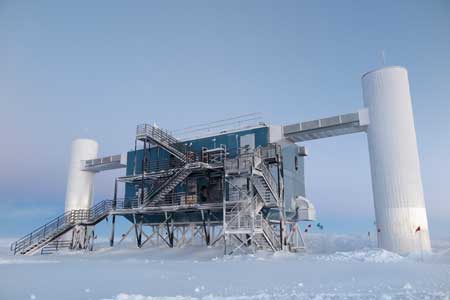| Sep 25, 2017 |
IceCube helps demystify strange radio bursts from deep space
|
|
(Nanowerk News) For a decade, astronomers have puzzled over ephemeral but incredibly powerful radio bursts from space.
|
|
The phenomena, known as fast radio bursts or FRBs, were first detected in 2007 by astronomers scouring archival data from Australia's Parkes Telescope, a 64-meter diameter dish best known for its role receiving live televison images from the Apollo 11 moon landing in 1969.
|
|
But the antenna's detection of the first FRB -- and the subsequent confirmed discovery of nearly two dozen more powerful radio pulses across the sky by Parkes and other radio telsescopes -- has sent astrophysicists scurrying to find more of the objects and to explain them.
|
|
"It's a new class of astronomical events. We know very little about FRBs in general," explains Justin Vandenbroucke, a University of Wisconsin-Madison physicist who, with his colleagues, is turning IceCube, the world's most sensitive neutrino telescope, to the task of helping demystify the powerful pulses of radio energy generated up to billions of light-years from Earth.
|
|
The idea, the Wisconsin physicist says, is to see if high-energy neutrinos are generated coincident with FRBs. If that's the case, it would give scientists leads to what might be generating the powerful radio flares and reveal something about the physics of the environments where they are generated.
|
 |
| IceCube is a neutrino detector composed of 5,160 optical modules embedded in a gigaton of crystal-clear ice a mile beneath the geographic South Pole. (Image: National Science Foundation)
|
|
IceCube is a neutrino detector composed of 5,160 optical modules embedded in a gigaton of crystal-clear ice a mile beneath the geographic South Pole. Supported by the National Science Foundation, IceCube is capable of capturing the fleeting signatures of high-energy neutrinos -- nearly massless particles generated, presumably, by dense, violent objects such as supermassive black holes, galaxy clusters, and the energetic cores of star-forming galaxies.
|
|
The catch with fast radio bursts, notes Vandenbroucke, is that they are mostly random and they last for only a few milliseconds, too fast to routinely detect or conduct follow-up observations with radio and optical telescopes. Only one FRB has been found to repeat, an object known as FRB 121102 in a galaxy about 3 billion light-years away. A key advantage of IceCube is the telescope's extremely wide field of view compared to optical and radio telescopes. The telescope gathers data on neutrino events as the particles crash through the Earth, and it sees the entire sky in both the southern and northern hemispheres. That means if an FRB is detected by any of the world's radio telescopes, Vandenbroucke and his team can analyze IceCube data for that region of the sky at the time the radio pulse was detected.
|
|
Observing a fast radio burst in conjunction with neutrinos would be a coup, helping establish source objects for both types of phenomena. "Astrophysical neutrinos and fast radio bursts are two of the most exciting mysteries in physics today," says Vandenbroucke. "There may be a link between them."
|
|
So far, Vandenbroucke and his team have looked at nearly 30 FRBs, including 17 bursts from the "repeater," FRB 121102.
|
|
The UW team's first look, however, did not detect neutrino emission with any of the FRBs identified in IceCube's archival data. Not seeing neutrinos in concert with any of the FRBs studied so far gives scientists an upper limit on the amount of neutrino emission that could occur in a burst.
|
|
"We can say that the amount of energy emitted by each burst as neutrinos is less than a certain amount, which can then be compared to predictions from individual theories," Vandenbroucke explains. "As the number of bursts is expected to grow dramatically in the next couple years, these constraints will become even stronger -- or we will make a detection."
|
|
Bright or very high-energy neutrinos would be characteristic of certain classes of astronomical objects. "We've ruled out gamma-ray bursts and we've strongly constrained the possibility of black holes" as neutrino sources, says Vandenbroucke. His team's analysis of four FRB events was published in the August 2017 Astrophysical Journal. "There could be even more exotic physics going on."
|
|
Scientists believe FRBs occur much more frequently than they have been observed. Some estimate that there are as many as 10,000 FRB events per day coming from all directions in the sky. And with astronomers now on the lookout for the starnge pulses of radio energy, Vandenbroucke expects the pace of discovery to accelerate as the world's radio telescopes continue their searches and as new radio interferometers come on line.
|

